Coins of the United States dollar, aside from those of the earlier Continental currency were first minted in 1792. New coins have been produced annually and they make up a valuable aspect of the United States currency system. Circulating coins exist in denominations of 1¢, 5¢, 10¢, 25¢, 50¢, and $1.00. Also minted are bullion, including gold, silver and platinum, and commemorative coins. All of these are produced by the United States Mint. The coins are then sold to Federal Reserve Banks which in turn are responsible for putting coins into circulation and withdrawing them as demanded by the country's economy.

The Coinage Act of 1873 or Mint Act of 1873 was a general revision of laws relating to the Mint of the United States. By ending the right of holders of silver bullion to have it coined into standard silver dollars, while allowing holders of gold to continue to have their bullion made into money, the act created a gold standard by default. It also authorized a Trade dollar, with limited legal tender, intended for export, mainly to Asia, and abolished three small-denomination coins. The act led to controversial results and was denounced by critics as the "Crime of '73".

A nickel, sometimes mistakenly called a nickle, is a five-cent coin struck by the United States Mint. Composed of cupronickel, the piece has been issued since 1866. Its diameter is 0.835 inches (21.21 mm) and its thickness is 0.077 inches (1.95 mm).

The United States Mint is a bureau of the Department of the Treasury responsible for producing coinage for the United States to conduct its trade and commerce, as well as controlling the movement of bullion. The U.S. Mint is one of two U.S. agencies that produce money in the case of minting coinage; the other is the Bureau of Engraving and Printing, which prints paper currency. The first United States Mint was created in Philadelphia in 1792, and soon joined by other centers, whose coins were identified by their own mint marks. There are currently four active coin-producing mints: Philadelphia, Denver, San Francisco, and West Point.

The two-cent piece was produced by the Mint of the United States for circulation from 1864 to 1872 and for collectors in 1873. Designed by James B. Longacre, there were decreasing mintages each year, as other minor coins such as the nickel proved more popular. It was abolished by the Mint Act of 1873.

The eagle was a United States $10 gold coin issued by the United States Mint from 1795 to 1933.

The Coinage Act of 1792, passed by the United States Congress on April 2, 1792, created the United States dollar as the country's standard unit of money, established the United States Mint, and regulated the coinage of the United States. This act established the silver dollar as the unit of money in the United States, declared it to be lawful tender, and created a decimal system for U.S. currency.
Coinage Act is a stock short title used for legislation in the United Kingdom and the United States related to coinage.
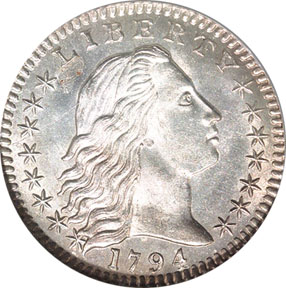
The half dime, or half disme, was a silver coin, valued at five cents, formerly minted in the United States.

The American twenty-cent piece is a coin struck from 1875 to 1878, but only for collectors in the final two years. Proposed by Nevada Senator John P. Jones, it proved a failure due to confusion with the quarter, to which it was close in both size and value.
The history of the United States dollar began with moves by the Founding Fathers of the United States of America to establish a national currency based on the Spanish silver dollar, which had been in use in the North American colonies of the Kingdom of Great Britain for over 100 years prior to the United States Declaration of Independence. The new Congress's Coinage Act of 1792 established the United States dollar as the country's standard unit of money, creating the United States Mint tasked with producing and circulating coinage. Initially defined under a bimetallic standard in terms of a fixed quantity of silver or gold, it formally adopted the gold standard in 1900, and finally eliminated all links to gold in 1971.

The Indian Head cent, also known as an Indian Head penny, was a one-cent coin ($0.01) produced by the United States Bureau of the Mint from 1859 to 1909. It was designed by James Barton Longacre, the Chief Engraver at the Philadelphia Mint.

The Flying Eagle cent is a one-cent piece struck by the Mint of the United States as a pattern coin in 1856 and for circulation in 1857 and 1858. The coin was designed by Mint Chief Engraver James B. Longacre, with the eagle in flight based on the work of Longacre's predecessor, Christian Gobrecht.

The Shield nickel was the first United States five-cent piece to be made out of copper-nickel, the same alloy of which American nickels are struck today. Designed by James B. Longacre, the coin was issued from 1866 until 1883, when it was replaced by the Liberty Head nickel. The coin takes its name from the motif on its obverse, and was the first five-cent coin referred to as a "nickel"—silver pieces of that denomination had been known as half dimes.
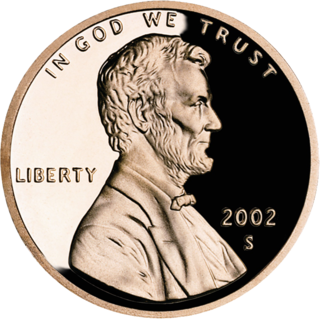
A debate exists within the United States government and American society at large over whether the one-cent coin, the penny, should be eliminated as a unit of currency in the United States. The penny costs more to produce than the one cent it is worth, meaning the seigniorage is negative – the government loses money on every penny that is created. Several bills introduced in the U.S. Congress would have ceased production of pennies, but none have been approved. Such bills would leave the five-cent coin, or nickel, as the lowest-value coin minted in the United States.
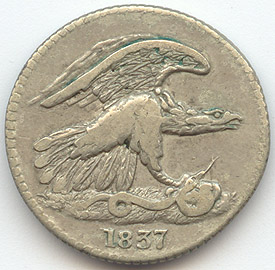
The Feuchtwanger cent was a nickel silver private token coin circulated in the U.S. by Lewis Feuchtwanger during the 1830s and 1840s. Three-cent varieties were also available, though not as plentiful as the one-cent tokens.

The United States dollar is the official currency of the United States and several other countries. The Coinage Act of 1792 introduced the U.S. dollar at par with the Spanish silver dollar, divided it into 100 cents, and authorized the minting of coins denominated in dollars and cents. U.S. banknotes are issued in the form of Federal Reserve Notes, popularly called greenbacks due to their predominantly green color.
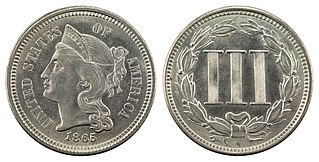
The copper-nickel three-cent piece, often called a three-cent nickel piece or three-cent nickel, was designed by US Mint Chief Engraver James B. Longacre and struck by the United States Bureau of the Mint from 1865 to 1889. It was initially popular, but its place in commerce was supplanted by the five-cent piece, or nickel.
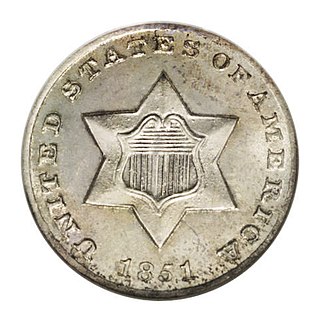
The three-cent silver, also known as the three-cent piece in silver or trime, was struck by the Mint of the United States for circulation from 1851 to 1872, and as a proof coin in 1873. Designed by the Mint's chief engraver, James B. Longacre, it circulated well while other silver coinage was being hoarded and melted, but once that problem was addressed, became less used. It was abolished by Congress with the Coinage Act of 1873.

The Coinage Act of 1853, 10 Stat. 160, was a piece of legislation passed by the United States Congress which lowered the silver content of the silver half dime, dime, quarter dollar, and half dollar, and authorized a three dollar gold piece. Although intending to stabilize the country's silver shortage, it, in effect, pushed the United States closer to abandoning bimetallism entirely and adopting the gold standard.















